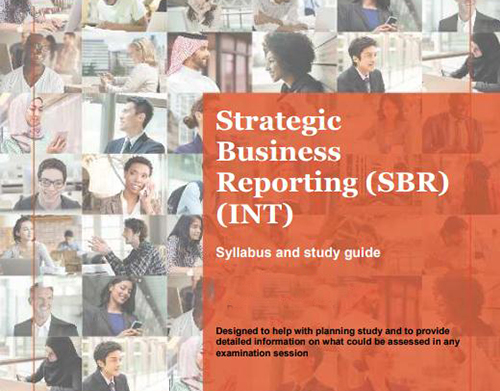SBR(P2)技术文章下载
ACCA SBR 技术文章(2020年)
Fundamental ethical and professional principles (A)
Accounting ethics in the digital age
The financial reporting framework (B)
Concepts of profit or loss and other comprehensive income
This article explains the current rules and the conceptual debate as to where in the statement of comprehensive income, profits and losses should be recognised – ie when should they be recognised in profit or loss and when in the other comprehensive income. Further, it explores the debate as to whether it is appropriate to recognise profits or losses twice.
Profit, loss and other comprehensive income
This article looks at what differentiates profit or loss from other comprehensive income and where items should be presented.
The Conceptual Framework
In March 2018, the International Accounting Standards Board finished its revision of The Framework for Financial Reporting.
Reporting the financial performance of a range of entities (C)
Deferred tax
This article considers the aspects of deferred tax that are relevant to the Financial Reporting exam before moving on to the more complicated situations that may be tested in the Strategic Business Reporting exam.
IFRS 2, Share-based Payment
International Financial Reporting Standard (IFRS®) 2, Share-based Payment, applies when a company acquires or receives goods and services for equity-based payment.
IFRS 9, Financial Instruments
IFRS® 9, Financial Instruments represents the outcome of work to date undertaken by the International Accounting Standards Board (the Board) in conjunction with the Financial Accounting Standards Board (FASB) in the US to improve and converge financial reporting standards.
IFRS 13, Fair Value Measurement
IFRS 13 has required a significant amount of work by entities to simply understand the nature of the principles and concepts involved
Impairment of financial assets
This article considers the International Accounting Standards Board’s proposals of new regulations for the impairment of financial assets.
Measurement
This article considers the relevance of information provided by different measurement methods and explains the effect that they may have on the financial statements.
Revenue revisited
This two-part article considers the application of IFRS 15, Revenue from Contracts with Customers using the five-step model.
When does debt seem to be equity?
The difference between debt and equity in an entity’s statement of financial position is not easy to distinguish for preparers of financial statements. Many financial instruments have both features with the result that this can lead to inconsistency of reporting.
Cryptocurrencies
Digital tokens are built on a distributed ledger infrastructure often referred to as a blockchain. These tokens can provide various rights. Cryptocurrency is a type of digital token, and is designed as a medium of exchange. Other digital tokens provide rights to use assets or services, or can represent ownership interests.
Financial statements of groups of entities (D)
Business Combinations – IFRS 3 (Revised)
This article provides an introduction to IFRS® 3 and IAS® 27, including piecemeal acquisitions and disposals.
Impairment of goodwill
This article discusses and shows both ways of measuring goodwill following the acquisition of a subsidiary, and how each measurement of goodwill is subject to an impairment review.
Interpret financial statements for different stakeholders (E)
Additional performance measures
For many years, regulators and standard-setters have debated how entities should best present financial performance and not mislead the user.
Giving investors what they need
This article looks at how reporting capital structure is challenging, but markets are keen for the information.
The integrated report framework
In 2013, the International Integrated Reporting Council (IIRC) released a framework for integrated reporting. The framework establishes principles and concepts that govern the overall content of an integrated report.
Using the business model of a company to help analyse its performance
Understanding the business model of an entity is helpful in analysing and communicating the essence of a business, and for predicting the implications of a change in circumstance on a business.
The impact of changes and potential changes in accounting regulation (F)
Bin the clutter
The effects of clutter have typically come in for little consideration by the preparers of annual reports. However, the phenomenon is increasingly under discussion, with initiatives recently launched to combat it.
IAS 21 – does it need amending?
This article examines the issues raised by IASB research that referred to a KASB study into whether IAS 21 needs amending.
The definition and disclosure of capital
This article is structured in two parts – first, it considers what might be included as the capital of a company and, second, why this distinction is important for the analysis of financial information.
The Sustainable Development Goals
The Sustainable Development Goals (SDGs) are 17 goals tackling major world issues agreed by 193 UN member states to be achieved by 2030. These goals include zero hunger, decent work and economic growth, and reduced inequalities.
ACCA SBR 技术文章(2019年)
Additional performance measures
For many years, regulators and standard-setters have debated how entities should best present financial performance and not mislead the user.
Bin the clutter
The effects of clutter have typically come in for little consideration by the preparers of annual reports. However, the phenomenon is increasingly under discussion, with initiatives recently launched to combat it.
Business Combinations – IFRS 3 (Revised)
This article provides an introduction to IFRS® 3 and IAS® 27, including piecemeal acquisitions and disposals.
Concepts of profit or loss and other comprehensive income
This article explains the current rules and the conceptual debate as to where in the statement of comprehensive income, profits and losses should be recognised – ie when should they be recognised in profit or loss and when in the other comprehensive income. Further, it explores the debate as to whether it is appropriate to recognise profits or losses twice.
Deferred tax
This article considers the aspects of deferred tax that are relevant to the Financial Reporting exam before moving on to the more complicated situations that may be tested in the Strategic Business Reporting exam.
Giving investors what they need
This article looks at how reporting capital structure is challenging, but markets are keen for the information.
IAS 21 – does it need amending?
This article examines the issues raised by IASB research that referred to a KASB study into whether IAS 21 needs amending.
IFRS 2, Share-based Payment
International Financial Reporting Standard (IFRS®) 2, Share-based Payment, applies when a company acquires or receives goods and services for equity-based payment.
IFRS 9, Financial Instruments
IFRS® 9, Financial Instruments represents the outcome of work to date undertaken by the International Accounting Standards Board (the Board) in conjunction with the Financial Accounting Standards Board (FASB) in the US to improve and converge financial reporting standards.
IFRS 13, Fair Value Measurement
IFRS 13 has required a significant amount of work by entities to simply understand the nature of the principles and concepts involved.
IFRS for SMEs
A focus on the International Financial Reporting Standard for small to medium-sized entities.
Impairment of financial assets
This article considers the International Accounting Standards Board’s proposals of new regulations for the impairment of financial assets.
Impairment of goodwill
This article discusses and shows both ways of measuring goodwill following the acquisition of a subsidiary, and how each measurement of goodwill is subject to an impairment review.
Measurement
This article considers the relevance of information provided by different measurement methods and explains the effect that they may have on the financial statements.
Profit, loss and other comprehensive income
This article looks at what differentiates profit or loss from other comprehensive income and where items should be presented.
Revenue revisited
This two-part article considers the application of IFRS 15, Revenue from Contracts with Customers using the five-step model.
The definition and disclosure of capital
This article is structured in two parts – first, it considers what might be included as the capital of a company and, second, why this distinction is important for the analysis of financial information.
The integrated report framework
In 2013, the International Integrated Reporting Council (IIRC) released a framework for integrated reporting. The framework establishes principles and concepts that govern the overall content of an integrated report.
When does debt seem to be equity?
The difference between debt and equity in an entity’s statement of financial position is not easy to distinguish for preparers of financial statements. Many financial instruments have both features with the result that this can lead to inconsistency of reporting.
ACCA SBR(P2) 技术文章
Technical articles
Additional performance measures
For many years, regulators and standard-setters have debated how entities should best present financial performance and not mislead the user.
Bin the clutter
The effects of clutter have typically come in for little consideration by the preparers of annual reports. However, the phenomenon is increasingly under discussion, with initiatives recently launched to combat it.
Concepts of profit or loss and other comprehensive income
This article explains the current rules and the conceptual debate as to where in the statement of comprehensive income, profits and losses should be recognised – ie when should they be recognised in profit or loss and when in the other comprehensive income. Further, it explores the debate as to whether it is appropriate to recognise profits or losses twice.
Giving investors what they need
This article looks at how reporting capital structure is challenging, but markets are keen for the information.
IAS 21 – does it need amending?
This article examines the issues raised by IASB research that referred to a KASB study into whether IAS 21 needs amending.
IFRS 13, Fair value measurement
IFRS 13 has required a significant amount of work by entities to simply understand the nature of the principles and concepts involved.
Impairment of financial assets
This article considers the International Accounting Standards Board’s proposals of new regulations for the impairment of financial assets.
Measurement
This article considers the relevance of information provided by different measurement methods and explains the effect that they may have on the financial statements.
Profit, loss and other comprehensive income
This article looks at what differentiates profit or loss from other comprehensive income and where items should be presented.
Revenue revisited
This two-part article considers the application of IFRS 15, Revenue from Contracts with Customers using the five-step model.
The definition and disclosure of capital
This article is structured in two parts – first, it considers what might be included as the capital of a company and, second, why this distinction is important for the analysis of financial information.
The integrated report framework
In 2013, the International Integrated Reporting Council (IIRC) released a framework for integrated reporting. The framework establishes principles and concepts that govern the overall content of an integrated report.






